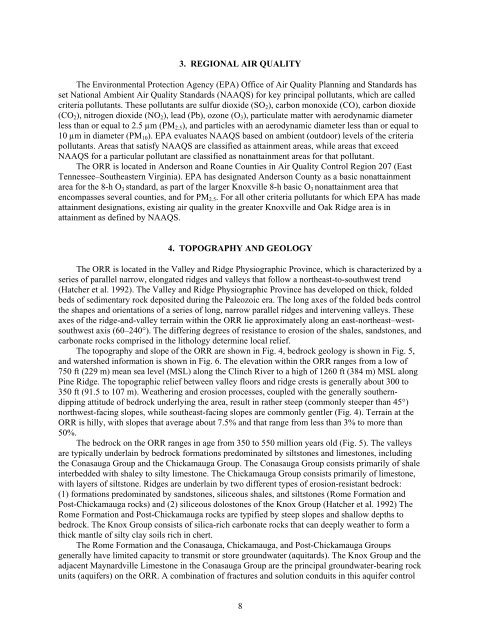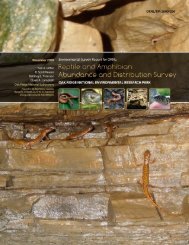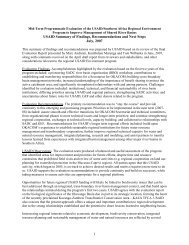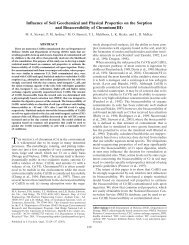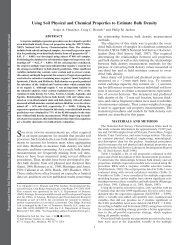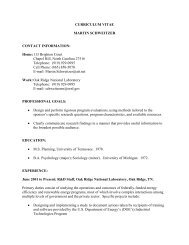oak ridge reservation physical characteristics and natural resources
oak ridge reservation physical characteristics and natural resources
oak ridge reservation physical characteristics and natural resources
Create successful ePaper yourself
Turn your PDF publications into a flip-book with our unique Google optimized e-Paper software.
3. REGIONAL AIR QUALITY<br />
The Environmental Protection Agency (EPA) Office of Air Quality Planning <strong>and</strong> St<strong>and</strong>ards has<br />
set National Ambient Air Quality St<strong>and</strong>ards (NAAQS) for key principal pollutants, which are called<br />
criteria pollutants. These pollutants are sulfur dioxide (SO 2 ), carbon monoxide (CO), carbon dioxide<br />
(CO 2 ), nitrogen dioxide (NO 2 ), lead (Pb), ozone (O 3 ), particulate matter with aerodynamic diameter<br />
less than or equal to 2.5 µm (PM 2.5 ), <strong>and</strong> particles with an aerodynamic diameter less than or equal to<br />
10 µm in diameter (PM 10 ). EPA evaluates NAAQS based on ambient (outdoor) levels of the criteria<br />
pollutants. Areas that satisfy NAAQS are classified as attainment areas, while areas that exceed<br />
NAAQS for a particular pollutant are classified as nonattainment areas for that pollutant.<br />
The ORR is located in Anderson <strong>and</strong> Roane Counties in Air Quality Control Region 207 (East<br />
Tennessee–Southeastern Virginia). EPA has designated Anderson County as a basic nonattainment<br />
area for the 8-h O 3 st<strong>and</strong>ard, as part of the larger Knoxville 8-h basic O 3 nonattainment area that<br />
encompasses several counties, <strong>and</strong> for PM 2.5 . For all other criteria pollutants for which EPA has made<br />
attainment designations, existing air quality in the greater Knoxville <strong>and</strong> Oak Ridge area is in<br />
attainment as defined by NAAQS.<br />
4. TOPOGRAPHY AND GEOLOGY<br />
The ORR is located in the Valley <strong>and</strong> Ridge Physiographic Province, which is characterized by a<br />
series of parallel narrow, elongated <strong>ridge</strong>s <strong>and</strong> valleys that follow a northeast-to-southwest trend<br />
(Hatcher et al. 1992). The Valley <strong>and</strong> Ridge Physiographic Province has developed on thick, folded<br />
beds of sedimentary rock deposited during the Paleozoic era. The long axes of the folded beds control<br />
the shapes <strong>and</strong> orientations of a series of long, narrow parallel <strong>ridge</strong>s <strong>and</strong> intervening valleys. These<br />
axes of the <strong>ridge</strong>-<strong>and</strong>-valley terrain within the ORR lie approximately along an east-northeast–westsouthwest<br />
axis (60–240°). The differing degrees of resistance to erosion of the shales, s<strong>and</strong>stones, <strong>and</strong><br />
carbonate rocks comprised in the lithology determine local relief.<br />
The topography <strong>and</strong> slope of the ORR are shown in Fig. 4, bedrock geology is shown in Fig. 5,<br />
<strong>and</strong> watershed information is shown in Fig. 6. The elevation within the ORR ranges from a low of<br />
750 ft (229 m) mean sea level (MSL) along the Clinch River to a high of 1260 ft (384 m) MSL along<br />
Pine Ridge. The topographic relief between valley floors <strong>and</strong> <strong>ridge</strong> crests is generally about 300 to<br />
350 ft (91.5 to 107 m). Weathering <strong>and</strong> erosion processes, coupled with the generally southerndipping<br />
attitude of bedrock underlying the area, result in rather steep (commonly steeper than 45°)<br />
northwest-facing slopes, while southeast-facing slopes are commonly gentler (Fig. 4). Terrain at the<br />
ORR is hilly, with slopes that average about 7.5% <strong>and</strong> that range from less than 3% to more than<br />
50%.<br />
The bedrock on the ORR ranges in age from 350 to 550 million years old (Fig. 5). The valleys<br />
are typically underlain by bedrock formations predominated by siltstones <strong>and</strong> limestones, including<br />
the Conasauga Group <strong>and</strong> the Chickamauga Group. The Conasauga Group consists primarily of shale<br />
interbedded with shaley to silty limestone. The Chickamauga Group consists primarily of limestone,<br />
with layers of siltstone. Ridges are underlain by two different types of erosion-resistant bedrock:<br />
(1) formations predominated by s<strong>and</strong>stones, siliceous shales, <strong>and</strong> siltstones (Rome Formation <strong>and</strong><br />
Post-Chickamauga rocks) <strong>and</strong> (2) siliceous dolostones of the Knox Group (Hatcher et al. 1992) The<br />
Rome Formation <strong>and</strong> Post-Chickamauga rocks are typified by steep slopes <strong>and</strong> shallow depths to<br />
bedrock. The Knox Group consists of silica-rich carbonate rocks that can deeply weather to form a<br />
thick mantle of silty clay soils rich in chert.<br />
The Rome Formation <strong>and</strong> the Conasauga, Chickamauga, <strong>and</strong> Post-Chickamauga Groups<br />
generally have limited capacity to transmit or store groundwater (aquitards). The Knox Group <strong>and</strong> the<br />
adjacent Maynardville Limestone in the Conasauga Group are the principal groundwater-bearing rock<br />
units (aquifers) on the ORR. A combination of fractures <strong>and</strong> solution conduits in this aquifer control<br />
8


